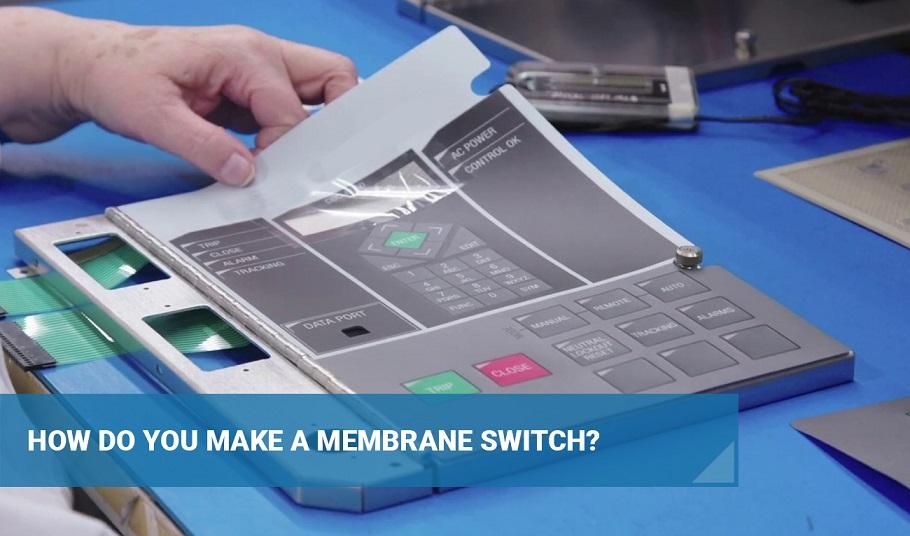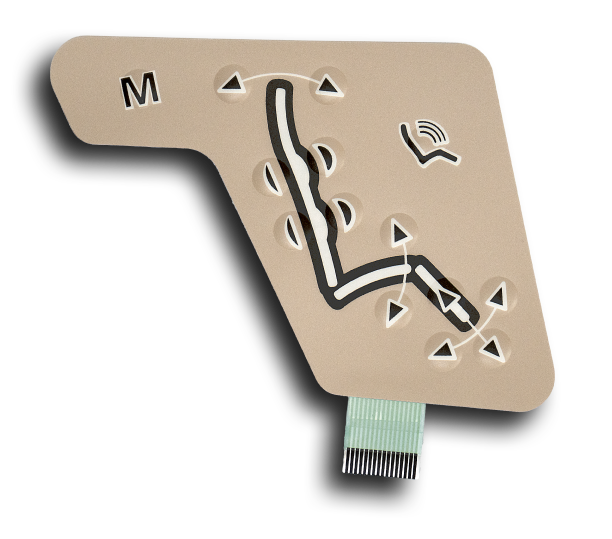Your Preferred Membrane Switch Manufacturer for Factory Applications
Your Preferred Membrane Switch Manufacturer for Factory Applications
Blog Article
Understanding the Significance of Membrane Switch in Modern Electronics and Their Applications
Membrane switches function as an important component in modern-day electronics, offering an effective interface for customer communication. Their light-weight and adjustable nature makes them suitable for a range of applications across diverse markets. Comprehending their vital parts and advantages can provide insights right into their expanding relevance. As innovation remains to breakthrough, the development of Membrane switches questions concerning their future applications and layout technologies. What lies in advance in this vibrant area?

What Are Membrane Buttons?
Membrane switches are essential components in modern electronics, acting as interface that help with interaction in between users and devices. These switches contain a number of layers, including a graphic overlay, a sticky layer, and a circuit layer, all of which job together to create a sturdy and practical user interface. The style permits a level, inconspicuous option that can be personalized pertaining to dimension, form, and visual appearance, making them ideal for different applications, from consumer electronic devices to clinical gadgets. The responsive responses given by Membrane switches over boosts customer experience, while their resistance to dust and moisture makes them ideal for challenging environments. In addition, Membrane switches can incorporate functions such as backlighting and printed graphics, even more increasing their functionality. Their adaptability and effectiveness make them a favored selection in sectors where integrity and ease of usage are extremely important, inevitably adding to the smooth operation of contemporary digital tools.
Trick Elements of Membrane Switches Over
While numerous parts add to the capability of a membrane layer switch, three main layers play substantial duties in its style and operation. The leading layer, typically made from a resilient polymer, acts as the user interface for user interaction, commonly featuring printed icons and graphics. Beneath this is the spacer layer, which preserves the needed distance between the leading layer and the circuit layer. This spacer layer assurances that the button triggers only when pushed, avoiding accidental inputs. The circuit layer has conductive traces that complete the electrical circuit when the leading layer is dispirited. These traces can be made from different materials, including copper or silver. With each other, these elements develop a dependable and robust tool that is portable and functional, ideal for a vast array of electronic applications, from household appliances to medical devices. Comprehending these essential elements is important for appreciating the overall capability of Membrane buttons.
Advantages of Utilizing Membrane Changes

Membrane Switch Production Refine
Comprehending the Membrane button manufacturing procedure discloses the complex actions included in generating these essential parts. The process usually begins with the layout phase, where specs and layouts are developed utilizing specialized software. Following this, the graphic overlay is printed on a flexible substrate, frequently using high-resolution printing strategies to assure clearness and precision.Next, the glue layers are applied, which serve to bond the various parts together. The circuit layers, made from conductive inks or materials, are then printed onto a separate substrate. These layers are very carefully aligned and laminated to create a functional switch.After assembly, the buttons go through evaluating to confirm capability and sturdiness. Quality control actions are implemented throughout the process to recognize and remedy any flaws. The completed Membrane switches are packaged and prepared for distribution, prepared to fulfill the needs of modern-day digital applications.
Applications of Membrane Switches Over in Different Industries
Membrane buttons are significantly made use of across various sectors, especially in clinical equipment and customer electronic devices. In the clinical field, they supply reliable control interfaces for gadgets that call for exact procedure. In a similar way, in consumer electronic devices, these buttons enhance individual communication by supplying smooth and responsive user interfaces.
Medical Equipment Control
Various modern clinical devices utilize Membrane switches for structured procedure and boosted individual communication. These buttons give a reputable, sturdy interface for a selection of applications, including diagnostic tools, person monitoring systems, and surgical instruments. Their adjustable layouts allow for specific designs that can fit the distinct demands of medical care professionals, guaranteeing user-friendly navigating and reliable accessibility to essential functions. Furthermore, Membrane switches are immune to pollutants, making them appropriate for clean and sterile atmospheres. The tactile responses they provide can improve individual self-confidence, decreasing the risk of errors during important medical treatments. Overall, the integration of Membrane switches in medical devices significantly adds to boosted operational efficiency and patient security in medical care setups.
Consumer Electronic Devices Interfaces
In the domain of consumer electronic devices, Membrane switches play an important role in boosting interface across a variety of gadgets. These buttons are indispensable to items such as push-button controls, microwaves, and pc gaming consoles, supplying a user-friendly and reliable interface. Their design permits a seamless combination go to my blog of graphics and capability, allowing producers to create streamlined, modern-day visual appeals without jeopardizing usability. Membrane buttons are also known her comment is here for their sturdiness, commonly withstanding extensive usage and exposure to numerous ecological conditions. Additionally, they can integrate attributes like backlighting and responsive comments, further enhancing the user experience. As consumer needs for innovative yet intuitive user interfaces expand, Membrane switches over continue to be an important component ahead of time electronic gadget functionality.
Layout Factors To Consider for Membrane Changes
Designing efficient Membrane switches calls for cautious interest to different variables that affect both capability and user experience. One important factor to consider is the choice of products, as they can influence resilience, responsive responses, and aesthetic allure. Selecting a suitable adhesive is necessary for assuring lasting attachment and resistance to environmental factors.In enhancement, the format and design of the switch should accommodate individual interaction, with switch dimensions and spacing maximized for ease of usage. The unification of graphics and labeling ought to focus on quality and exposure under different illumination conditions.Consideration of electric features, such as actuation pressure and button sensitivity, will enhance the responsiveness of the Membrane switch. The design should accommodate manufacturing processes to ensure cost-effectiveness and timely manufacturing. On the whole, a well-thought-out design boosts both the functionality and the customer experience of Membrane switches in contemporary electronics.

Future Fads in Membrane Switch Technology
As modern technology remains to develop, Membrane buttons are poised to integrate new improvements that will certainly boost their capability and application in various fields. One considerable fad is the consolidation of versatile and durable materials, which will certainly enhance the life-span and reliability of these switches. Improved surface area structures and customizable graphics are likewise prepared for, enabling more user-friendly individual interfaces.Moreover, the combination of smart innovation, such as touch-sensitive surfaces and haptic comments, is expected to boost individual communication, making Membrane changes much more engaging and responsive. Additionally, breakthroughs in printed electronic devices will certainly make it possible for a lot more intricate circuitry within thinner profiles, even more increasing design possibilities.Sustainability will also play an essential duty in future developments, as manufacturers discover green products and production procedures. Generally, these patterns will certainly ensure that Membrane switches over stay crucial and relevant in a increasingly electronic and interconnected globe.
Regularly Asked Inquiries
How Do Membrane Switches Over Contrast to Conventional Mechanical Switches?
Membrane changes offer benefits over conventional mechanical buttons, including minimized size, lighter weight, and boosted toughness. They commonly give a secured surface, improving resistance to dust and moisture, making them perfect for varied applications.
What Products Are Generally Made Use Of in Membrane Switch Building And Construction?

Can Membrane Switches Withstand Extreme Environmental Conditions?
Membrane switches can withstand severe ecological problems, depending upon their style and materials. Top notch buildings typically include toughness against temperature level fluctuations, humidity, and direct exposure to chemicals, making them suitable for numerous requiring applications throughout markets.
The Length Of Time Do Membrane Switches Over Generally Last Prior To Failing?
Membrane switches normally show a lifespan varying from 1 to 10 million actuations, depending on factors such as use regularity, ecological conditions, and making high quality. Routine maintenance can expand their sturdiness and functional reliability substantially.
Are Membrane Switches Over Adjustable for Specific Applications?
Membrane switches are certainly customizable for details applications. They can be tailored in size, style, and functionality, permitting manufacturers to satisfy special user needs and boost item looks while maintaining functional effectiveness and toughness. Membrane switches are essential components in modern electronics, serving as customer interfaces that help with interaction in between gadgets and customers. The tactile responses offered by Membrane switches over enhances user experience, while their resistance to dirt and moisture makes them excellent for challenging environments. The unification of graphics and labeling ought to focus on quality and presence under numerous lighting conditions.Consideration of electric attributes, such as actuation force and switch level of sensitivity, will boost the responsiveness of the Membrane switch. Enhanced surface textures and personalized graphics are likewise prepared for, allowing for even more intuitive customer interfaces.Moreover, the assimilation of wise technology, such as touch-sensitive surface areas and haptic feedback, is anticipated to boost customer communication, making Membrane changes extra receptive and engaging. Membrane switches over deal advantages over traditional mechanical buttons, including lowered dimension, lighter weight, and enhanced toughness.
Report this page